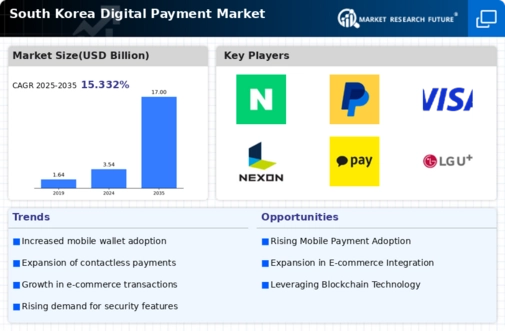Consumer Preference for Convenience
Consumer behavior in South Korea is increasingly favoring convenience, which significantly impacts the digital payment market. A growing number of consumers prefer cashless transactions due to their speed and ease of use. Surveys indicate that over 70% of South Koreans have adopted mobile payment methods, reflecting a cultural shift towards digital solutions. This preference is further fueled by the rise of e-commerce, where seamless payment experiences are essential for customer satisfaction. As online shopping continues to expand, the demand for efficient digital payment options is likely to increase. Retailers are responding by integrating various payment methods, including mobile wallets and QR codes, into their platforms. This trend not only enhances the shopping experience but also drives the growth of the digital payment market, as businesses strive to meet evolving consumer expectations.
Rise of E-commerce and Online Services
The surge in e-commerce and online services is a pivotal factor driving the digital payment market in South Korea. As of 2025, e-commerce sales are expected to surpass $150 billion, creating a substantial demand for efficient payment solutions. Consumers increasingly prefer online shopping due to its convenience, leading to a corresponding rise in digital payment transactions. This trend is further supported by the proliferation of mobile applications that facilitate seamless payment experiences. Retailers are adapting by offering diverse payment options, including digital wallets and installment plans, to cater to consumer preferences. The integration of payment solutions within e-commerce platforms not only enhances user experience but also drives the growth of the digital payment market, as businesses seek to capitalize on the expanding online consumer base.
Technological Advancements in Payment Systems
The digital payment market in South Korea is experiencing rapid growth due to technological advancements in payment systems. Innovations such as Near Field Communication (NFC) and biometric authentication are enhancing transaction security and convenience. As of 2025, mobile payment transactions are projected to reach approximately $100 billion, indicating a robust shift towards digital solutions. The integration of Artificial Intelligence (AI) in fraud detection is also becoming prevalent, allowing for real-time monitoring and risk assessment. This technological evolution not only streamlines the payment process but also builds consumer trust, which is crucial for the digital payment market. Furthermore, the increasing penetration of smartphones and high-speed internet access supports the adoption of these advanced payment technologies, making them more accessible to the general public.
Increased Focus on Security and Fraud Prevention
Security concerns are paramount in the digital payment market, particularly in South Korea, where cyber threats are prevalent. As digital transactions increase, so does the need for robust security measures. Financial institutions and payment service providers are investing heavily in advanced security technologies, such as encryption and tokenization, to protect consumer data. In 2025, it is estimated that spending on cybersecurity in the financial sector will reach $10 billion, underscoring the importance of safeguarding digital transactions. This heightened focus on security not only reassures consumers but also encourages wider adoption of digital payment methods. As trust in digital payment systems grows, the market is likely to expand, driven by the assurance that transactions are secure and reliable.
Government Initiatives Promoting Cashless Society
The South Korean government is actively promoting a cashless society, which serves as a significant driver for the digital payment market. Initiatives such as tax incentives for cashless transactions and campaigns to reduce cash usage are being implemented. In 2025, the government aims to increase the share of cashless transactions to 80% of total payments, reflecting a strong commitment to digitalization. These policies are designed to enhance transparency in financial transactions and reduce the costs associated with cash handling. Additionally, the government is investing in infrastructure to support digital payment systems, including the expansion of secure payment networks. This proactive approach not only encourages consumer adoption but also fosters innovation within the digital payment market, as new players and technologies emerge to meet regulatory standards.























Leave a Comment